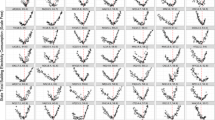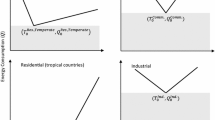Abstract
Climate is a major determinant of energy demand. Changes in climate may alter energy demand as well as energy demand patterns. This study investigates the implications of climate change for energy demand under the hypothesis that impacts are scale dependent due to region-specific climatic variables, infrastructure, socioeconomic, and energy use profiles.
In this analysis we explore regional energy demand responses to climate change by assessing temperature-sensitive energy demand in the Commonwealth of Massachusetts. The study employs a two-step estimation and modeling procedure. The first step evaluates the historic temperature sensitivity of residential and commercial demand for electricity and heating fuels, using a degree-day methodology. We find that when controlling for socioeconomic factors, degree-day variables have significant explanatory power in describing historic changes in residential and commercial energy demands. In the second step, we assess potential future energy demand responses to scenarios of climate change. Model results are based on alternative climate scenarios that were specifically derived for the region on the basis of local climatological data, coupled with regional information from available global climate models. We find notable changes with respect to overall energy consumption by, and energy mix of the residential and commercial sectors in the region. On the basis of our findings, we identify several methodological issues relevant to the development of climate change impact assessments of energy demand.
Similar content being viewed by others
References
Badri, M. A.: 1992, ‘Analysis of demand for electricity in the United States’, Energy 17(7), 725–733.
Barron, E.: 2002, Potential consequences of climate variability and change for the northeastern United States, Climate Change Impacts on the United States: The Potential Consequences of Climate Variability and Change, National Assessment Synthesis Team.
Belzer, D. B., Scott, M. J. et al.: 1996, ‘Climate change impacts on U.S. commercial building energy consumption: An analysis using sample survey data’, Energy Sources 18(2), 177–201.
BLS: 2003, ‘Consumer price index for electricity’ (Series ID: CUURA103SEHF01), www.bls.gov.
BLS: 2003, ‘Consumer price index for fuels’ (Series ID: CUURA103SAH21), www.bls.gov.
Boustead, I. and Yaros, B. R.: 1994, ‘Electricity supply industry in North America’, Resources, Conservation Recycl. 12(3–4), 121–134.
Camilleri, M., Jaques, R. et al.: 2001, ‘Impacts of climate change on building performance in New Zealand’, Building Res. Inform. 29(6), 440–450.
Cartalis, C., Synodinou, A. et al.: 2001, ‘Modifications in energy demand in urban areas as a result of climate changes: An assessment for the southeast Mediterranean region’, Energy Conversion Manage. 42, 1647–1656.
Colombo, A. F., Etkin, D. et al.: 1999, ‘Climate variability and the frequency of extreme temperature events for nine sites across Canada: Implications for power usage’, J. Climate 12(8), 2490–2502.
de Dear, R. and Brager, G. S.: 2001, ‘The adaptive model of thermal comfort and energy conservation in the built environment’, Int. J. Biometeorol. 45, 100–108.
Downton, M. W., Stewart, T. R. et al.: 1988, ‘Estimating historical heating and cooling needs: Per capita degree-days’, J. Appl. Meteorol. 27(1), 84–90.
EIA: 1995, Measuring Energy Efficiency in the United States, Economy: A Beginning, U.S. Department of Energy, Washington, DC.
EIA: 1999, A Look at Residential Energy Consumption in 1997, Energy Information Administration, Washington, DC.
EIA: 2001, Annual Energy Review 2000, Department of Energy, Washington, DC.
EIA: 2001, State Energy Data Report 1999, U.S. Department of Energy, Washington, DC.
EIA: various years, Electric Power Monthly.
EIA: various years, Natural Gas Monthly.
EIA: various years, Petroleum Marketing Monthly.
Elkhafif, M.: 1996, ‘An iterative approach for weather-correcting energy consumption data’, Energy Econ. 18(3), 221–230.
Greco, S., Moss, R. H. et al.: 1994, Climate Scenarios and Socioeconomic Projections for IPCC WG II Assessment, IPCC – WMO and UNEP: 67, Washington, DC.
Grubler, A.: 1990, The Rise and Fall of Infrastructures, Physica-Verlag, Heidelberg, Germany.
Harmel, R. D., Richardson, C. W. et al.: 2002, ‘Evaluating the adequacy of simulating maximum and minimum daily air temperature with the normal distribution’, J. Appl. Meteorol. 41(7), 744–753.
IPCC: 1996, Climate Change 1995: Impacts, Adaptation and Mitigation of Climate Change.
IPCC: 2001, Climate Change 2001: Impacts, Adaptation and Vulnerability, Intergovernmental Panel on Climate Change, Geneva.
Jager, J.: 1983, Climate and Energy Systems: A Review of their Interactions, John Wiley & Sons, New York, NY.
Lakshmanan, T. R. and Anderson, W.: 1980, ‘Residential energy demand in the United States: A regional econometric analysis’, Regional Sci. Urban Econ. 10, 371–386.
Lam, J. C.: 1998, ‘Climatic and economic influences on residential electricity consumption’, Energy Conversion Manage. 39(7), 623–629.
Le Comte, D. M. and Warren, H. E.: 1981, ‘Modeling the impact of summer temperatures on national electricity consumption’, J. Appl. Meteorol. 20, 1415–1419.
Lehman, R. L.: 1994, ‘Projecting monthly natural gas sales for space heating using a monthly updated model and degree-days from monthly outlooks’, J. Appl. Meteorol. 33(1), 96–106.
Linder, K. P.: 1990, National Impacts of Climate Change on Electric Utilities, in Smith, J. B. and Tirpak, D. A. (eds.), The Potential Effects of Global Warming on the United States, Environmental Protection Agency, Washington, DC.
Morris, M.: 1999, The Impact of Temperature Trends on Short-Term Energy Demand, EIA 2001.
Morrison, W. and Mendelsohn, R.: 1998, The Impacts of Climate Change on Energy: An Aggregate Expenditure Model for the US, U.S. Department of Energy, Washington, DC.
Nall, D. and Arens, E.: 1979, ‘The influence of degree-day base temperature on residential building energy prediction’, ASHRAE Trans. 85, 1.
New England Regional Assessment Group: 2001, Preparing for a Changing Climate: The Potential Consequences of Climate Variability and Change, New England Regional Overview; US Global Change Research Program, University of New Hampshire.
NOAA: 2003, ‘Sunrise/sunset calculator’, http://www.srrb.noaa.gov/highlights/sunrise/sunrise.html.
Pardo, A., Meneu, V. et al.: 2002, ‘Temperature and seasonality influences on the Spanish electricity load’, Energy Econ. 24(1), 55–70.
Pressman, N.: 1995, Northern Cityscape: Linking Design to Climate, Winter Cities Association, Yellowknife, Canada.
Quayle, R. G. and Diaz, H. F.: 1979, ‘Heating degree-day data applied to residential heating energy consumption’, J. Appl. Meteorol. 19, 241–246.
Rosenthal, D. H., Gruenspecht, H. K. et al.: 1995, ‘Effects of global warming on energy use for space heating and cooling in the united states’, The Energy J. 16(2), 41–54.
Ruth, M. and Kirshen, P.: 2001, ‘Integrated impacts of climate change upon infrastructure systems and services in the Boston metropolitan area’, World Resources Rev. 13(1), 106–122.
Sailor, D. J.: 1997, ‘Climatic change feedback to the energy sector: Developing integrated assessments’, World Resource Rev. 9(3), 301–316.
Sailor, D. J.: 2001, ‘Relating residential and commercial sector electricity loads to climate – evaluating state level sensitivities and vulnerabilities’, Energy 26, 645–657.
Sailor, D. J. and Munoz, J. R.: 1997, ‘Sensitivity of electricity and natural gas consumption to climate in the USA – methodology and results for eight states’, Energy 22(10), 987–998.
Sailor, D. J. and Pavlova, A. A.: 2003, ‘Air conditioning market saturation and long-term response of residential cooling energy demand to climate change’, Energy 28(9), 941–951.
Sailor, D. J., Rosen, J. N. et al.: 1998, ‘Natural gas consumption and climate: A comprehensive set of predictive state-level models for the United States’, Energy 23(2), 91–103.
Scott, M. J., Wrench, L. E. et al.: 1994, ‘Effects of climate change on commercial building energy demand’, Energy Sources 16, 317–332.
Segal, M., Shafir, H. et al.: 1992, ‘Climatic-related evaluations of the summer peak-hours’ electric load in Israel’, J. Appl. Meteorol. 31(12), 1492–1498.
U.S. Bureau of Economic Analysis: 2002, ‘Total full-time and part-time employment by industry’, www.bea.doc.gov.
U.S. Census Bureau: 2002, State Population Estimates.
UNEP: 1998, Handbook on Methods for Climate Change Impact Assessment and Adaptation Strategies, United Nations Environmental Programme.
Vogel, R. M. and Shallcross, A. L.: 1996, ‘The moving blocks bootstrap versus parametric time series models’, Water Resources Res. 32(6), 1875–1882.
Warren, H. E. and LeDuc, S. K.: 1981, ‘Impact of climate on energy sector in economic analysis’, J. Appl. Meteorol. 20, 1431–1439.
Wilbanks, T. J. and Kates: R. W.: 1999, ‘Global change in local places: How scale matters’, Climatic Change 43, 601–628.
Yan, Y. Y.: 1998, ‘Climate and residential electricity consumption in Hong Kong’, Energy 23(1), 17–20.
Author information
Authors and Affiliations
Rights and permissions
About this article
Cite this article
Amato, A.D., Ruth, M., Kirshen, P. et al. Regional Energy Demand Responses To Climate Change: Methodology And Application To The Commonwealth Of Massachusetts. Climatic Change 71, 175–201 (2005). https://doi.org/10.1007/s10584-005-5931-2
Received:
Revised:
Issue Date:
DOI: https://doi.org/10.1007/s10584-005-5931-2




